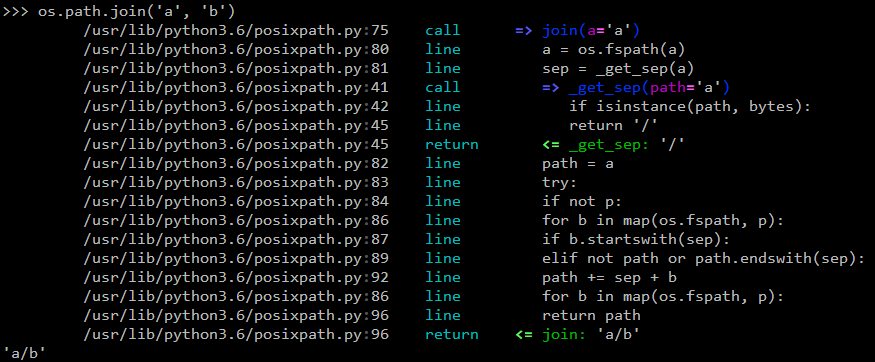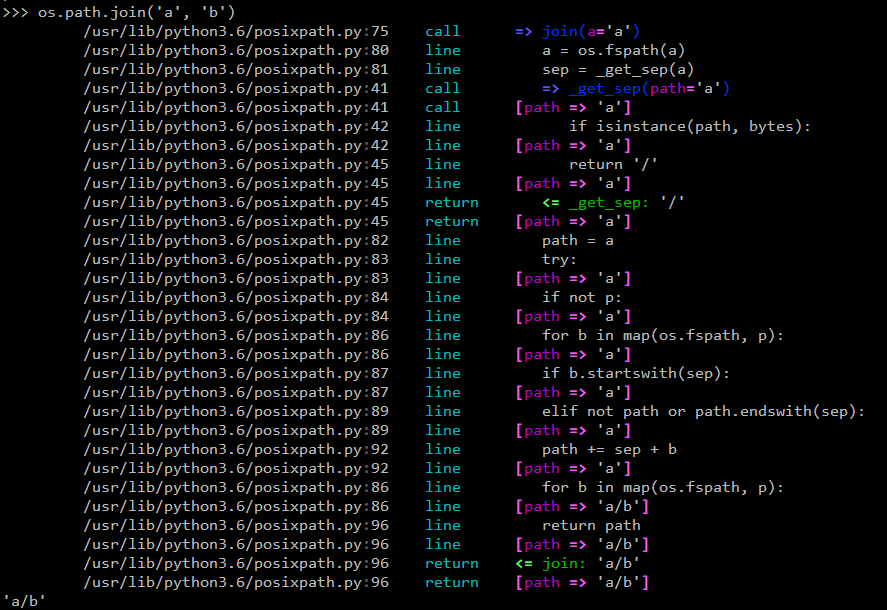Overview¶
| docs | |
|---|---|
| tests | |
| package |      |
Hunter is a flexible code tracing toolkit, not for measuring coverage, but for debugging, logging, inspection and other nefarious purposes. It has a simple Python API and a convenient terminal API (see Environment variable activation).
- Free software: BSD license
Installation¶
pip install hunter
Documentation¶
Overview¶
The default action is to just print the code being executed. Example:
import hunter
hunter.trace(module='posixpath')
import os
os.path.join('a', 'b')
Would result in:
python2.7/posixpath.py:60 call def join(a, *p):
python2.7/posixpath.py:64 line path = a
python2.7/posixpath.py:65 line for b in p:
python2.7/posixpath.py:66 line if b.startswith('/'):
python2.7/posixpath.py:68 line elif path == '' or path.endswith('/'):
python2.7/posixpath.py:71 line path += '/' + b
python2.7/posixpath.py:65 line for b in p:
python2.7/posixpath.py:72 line return path
python2.7/posixpath.py:72 return return path
... return value: 'a/b'
- or in a terminal:

You can have custom actions, like a variable printer - example:
import hunter
hunter.trace(hunter.Q(module='posixpath', action=hunter.VarsPrinter('path')))
import os
os.path.join('a', 'b')
Would result in:
python2.7/posixpath.py:60 call def join(a, *p):
python2.7/posixpath.py:64 line path = a
vars path => 'a'
python2.7/posixpath.py:65 line for b in p:
vars path => 'a'
python2.7/posixpath.py:66 line if b.startswith('/'):
vars path => 'a'
python2.7/posixpath.py:68 line elif path == '' or path.endswith('/'):
vars path => 'a'
python2.7/posixpath.py:71 line path += '/' + b
vars path => 'a/b'
python2.7/posixpath.py:65 line for b in p:
vars path => 'a/b'
python2.7/posixpath.py:72 line return path
vars path => 'a/b'
python2.7/posixpath.py:72 return return path
... return value: 'a/b'
- or in a terminal:

You can give it a tree-like configuration where you can optionally configure specific actions for parts of the tree (like dumping variables or a pdb set_trace):
TODO: More examples.
Environment variable activation¶
For your convenience environment variable activation is available. Just run your app like this:
PYTHONHUNTER="module='os.path'" python yourapp.py
On Windows you’d do something like:
set PYTHONHUNTER=module='os.path'
python yourapp.py
The activation works with a clever .pth file that checks for that env var presence and before your app runs does something
like this:
from hunter import *
trace(<whatever-you-had-in-the-PYTHONHUNTER-env-var>)
Note that Hunter is activated even if the env var is empty, eg: PYTHONHUNTER="".
Filtering DSL¶
Hunter supports a flexible query DSL, see the introduction.
FAQ¶
Why not Smiley?¶
There’s some obvious overlap with smiley but there are few fundamental differences:
Complexity. Smiley is simply over-engineered:
- It’s uses IPC and a SQL database.
- It has a webserver. Lots of dependencies.
- It uses threads. Side-effects and subtle bugs are introduced in your code.
- It records everything. Tries to dump any variable. Often fails and stops working.
Why do you need all that just to debug some stuff in a terminal? Simply put, it’s a nice idea but the design choices work against you when you’re already neck-deep into debugging your own code. In my experience Smiley has been very buggy and unreliable. Your mileage might way of course.
Tracing long running code. This will make Smiley record lots of data, making it unusable.
Now because Smiley records everything, you’d think it’s better suited for short programs. But alas, if your program runs quickly then it’s pointless to record the execution. You can just run it again.
It seems there’s only one situation where it’s reasonable to use Smiley: tracing io-bound apps remotely. Those apps don’t execute lots of code, they just wait on network so Smiley’s storage won’t blow out of proportion and tracing overhead might be acceptable.
Use-cases. It seems to me Smiley’s purpose is not really debugging code, but more of a “non interactive monitoring” tool.
In contrast, Hunter is very simple:
Few dependencies.
Low overhead (tracing/filtering code has an optional Cython extension).
No storage. This simplifies lots of things.
The only cost is that you might need to run the code multiple times to get the filtering/actions right. This means Hunter is not really suited for “post-mortem” debugging. If you can’t reproduce the problem anymore then Hunter won’t be of much help.
Why (not) coverage?¶
For purposes of debugging coverage is a great tool but only as far as “debugging by looking at what code is (not) run”. Checking branch coverage is good but it will only get you as far.
From the other perspective, you’d be wondering if you could use Hunter to measure coverage-like things. You could do it but for that purpose Hunter is very “rough”: it has no builtin storage. You’d have to implement your own storage. You can do it but it wouldn’t give you any advantage over making your own tracer if you don’t need to “pre-filter” whatever you’re recording.
In other words, filtering events is the main selling point of Hunter - it’s fast (cython implementation) and the query API is flexible enough.


